WATER PROBLEMS
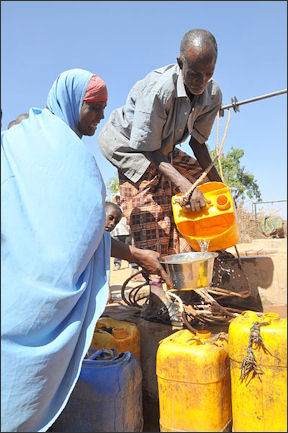
drought in Somalia The main problems with water are shortages of water, shortages of clean water and waterborne diseases. Around 80 percent of all deaths from illness in the developing world are caused by lack of access to safe water. More than 5 million people die each year from water-related diseases such as severe diarrhea, hepatitis A and dysentery.
More than 1 billion people worldwide lack access to safe drinking water and 2.6 billion people lack sanitation. More than 80 countries representing 40 percent of the world’s population regularly experience serious water shortages. In sub-Saharan Africa half of most people’s water consumption takes place outside the home. The International Water Management Institute (IWMI) estimates that one third of humans lacks reliable access to safe water either because the water is unsafe, unaffordable or unavailable. By 2025 the United Nations predicts 3 billion people will be seeking clean water.
Demand for water is currently increasing at a rate faster than population growth. Over the past 70 years, while the world’s population has tripled demand for water has increased sixfold. The United Nations estimates that in 2025 that 5 billion of the world’s 8 billion people will live in areas where water is scarce and many of these people will have difficulty attaining enough water to meet their basic needs.
Growing populations, expanding agriculture, industrialization and high living standards have all boosted demand for water while drought, overuse and pollution have all decreased supplies. To make up for the shortfall water is often taken from lakes, rivers and wetlands, causing serious environmental damage. According to a 2003 United Nations report, “Across the globe, groundwater is being depleted by the demands of megacities and agriculture, while fertilizer runoff and pollution are threatening water quality and public health.”
Every week it seems there are alarming predictions related to water: disease, starvation, crop disasters, famines, war. One of the major challenge in many developing countries is to provide decent drinking water and sanitation to sprawling shanty towns and areas occupied by the urban poor in the cities. In rural area at least the poor can dig wells and take care of the sanitation in their fields.
In many places people have water to drink. What they lack is safe water to drink. Open defecation is a standard practice in many parts of the developing world and run off from this inevitably dirties local water supplies. In 2007, the United Nations declared water a “global crisis” and more or less said a U.N. Millennium Development Goal of halving the proportion of people without clean water between 2000 and 2015 was heading for failure. The United Nations has realized there was a problem for some time. It declared the 1980s “the decade of water” but made little headway on the problem then.
Water Disputes
Access to drinking water
in the Third World Scientists and government officials predict that in the coming decades water, not oil, will become the most important resource and the one that holds the greatest potential for conflict. Disputes between countries over water could escalate into war. There has been some discussion of setting up peacekeeping forces to deal with water disputes.
The United Nations has yet to develop a scheme on how to divide the water of major rivers between countries that share it. This applies to the Nile, the Danube, the Euphrates River and others. The greatest potential for conflict involves countries with mountains that are sources of rivers sometimes build dams that prevent water from reaching neighboring countries, which are not comfortable with the fact that source country has the power to cut off or greatly reduce their water supply.
There are political problems and potentials for war if two countries extract water from the same aquifer. None of the numerous treaties on water use cover underground water. There are also conflicts within countries as to who will get water: primarily between industries, cities and farms. Environmental refugees from places with water shortages flock to the rich countries.
Wasted Water and PET Bottles
Water is wasted because of bad drainage, water pipes that leak, evaporation from reservoirs and canals, poor irrigation and industrial practices, and lack of wastewater and drinking water treatment.
Bottled water is also a problem: not so much because it wastes water but because it wastes energy and money. Even in the developing world, people are becoming increasingly dependent on bottled water from private companies rather than developing public water systems. In some cases the poor spend a large percentage of their income on water from private source for water that should come virtually free from the tap. In some cases residents of slums in pay four times for water what Americans pay.
PET (polyethylene terephthalate) bottles make up about 0.25 percent of total worldwide oil consumption. One bottle is made of 24 grams of ethylene and paraxylene, both chemicals derived from crude oil. The biggest waste of energy is not the oil used to make the bottles as much as it is the energy costs of moving all this water great distances when water that is just as good is available for 1/10,000th the price from the tap. Many bottles end up as litter.
Polluted Water
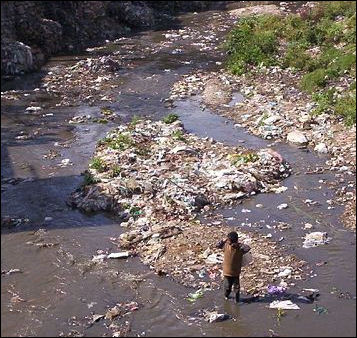
People often bathe, wash their clothes and swim in disgusting water. They often drink water of dubious quality obtained from ponds and streams used by animals.
Agriculture-related water pollution comes from fertilizer, pesticides, herbicides, animal waste, salts from evaporated irrigation water, and silt from deforestation that wash into streams, rivers, lakes, ponds and the sea. Agricultural runoff is sometimes so severe it creates “dead zones” in coastal water zones.
Industry-related water pollution comes from toxic chemicals and heavy metals from manufacturing and mining. Power plant emissions create acid rain which contaminates surface water.
Much of the pollution in rural areas is caused by untreated sewage resulting from a lack of toilets and sewers; salts, fertilizers and pesticides from irrigated land that contaminates flowing water and groundwater supplies; and salt water entering overused aquifers. Places with sewers often have no waste-water treatment facilities and sewage is dumped directly into water supplies from which people draw their water.
The air and water around the cities is polluted but the rural areas are so vast pollution nationwide is not a big problem.
Water Shortages
Many countries face serious water shortages, with the root of the problem being not so much shortages of water but overpopulation in places that are not really fit for human habitation. Water shortages are often local problems rather than national ones. Shortages are worse in places where there is little water or rain and lots of people. Global warming could make water shortages worse in some places and create water shortages in other places.
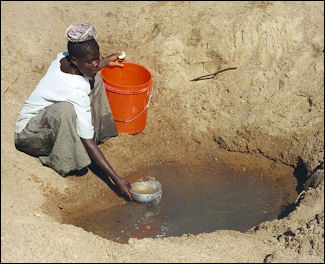
Water shortages are a global problem and are particularly serious in arid regions. Causes of water shortages include swelling population, depletion of groundwater, wasteful irrigation, waste, pollution and global warming. In many places agriculture relies too much on ground water for irrigation. In urban areas many people illegally tap into water supplies without paying for it. In places where there is ample water is wasted in leaky pipes and other substandard infrastructure. Fixing leak pipes is an expensive, time-consuming endeavor that can take decades to complete.
The World Meteorological Organization regards drinking water shortages as among the primary obstacles to sustainable development. Currently one third of humanity experiences permanent water shortages. Two thirds may experience the problem if population and global warming trends continue.
The average amount of water used by some people per day in countries like Somalia, Mali, Mozambique, Eritrea, Ethiopia, Gambia, Tanzania, Uganda and Djibouti is equal to what people in some developed countries use when they run the tap while brushing their teeth.
Water tables are falling almost everywhere. Repeated drilling and well building has caused the water table to drop in some places by as much as six feet a year. Rich countries can compensate for shortages in some areas by building dams, importing food, tapping deep water aquifers, recycling wastewater, desalinated seawater. Poor countries are generally unable to do these things.
The shortage of water is a big problem in many cities. Water is sometimes turned on only a couple of times a day for about a half hour each time. People with money have special storage tanks to collect water during those times, which in turn allows them to have water around the clock. People without storage tanks collect water in jugs and buckets and often have to take bucket baths when the water is not turned on.
Reports: “The U.N. World Water Development Report 2009 “ by UNESCO;”India’s Water Economy: Bracing for a Turbulent Future “ and “Pakistan’s Water Economy: Running Worry “ by the World Bank; and “Asia’s Next Challenge: Securing the Region’s water Future “.
See Separate Article WATER SHORTAGES IN CHINA factsanddetails.com
Consequence of Water Shortages
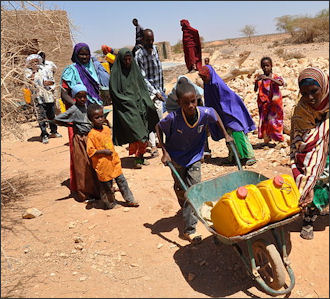
Somalia Drought
The consequence of water shortages include drought and famine, loss of livelihoods, the spread of water-borne disease, forced migrations and even conflicts.
Poverty expert Jeffrey Sachs of the Earth Institute of Columbia University wrote: “many conflicts are caused or inflamed by water scarcity. The conflicts from Chad to Darfur, Sudan to the Ogaden desert of Ethiopia to Somalia and it pirates and across to Yemen, Iraq, Pakistan and Afghanistan, lie in a great arc of arid lands, where water scarcity is leading to failed crops, dying livestock extreme poverty, and desperation.”
“Extremist groups like the Taliban find ample recruitment possibilities in such impoverished communities. Governments lose their legitimacy, when they cannot guarantee their populations’ most basic needs: safe drinking water, staple food crops, and fodder and water for animal herds on which communities depend for their meager livelihoods....Politicians, diplomats and generals in conflict-ridden countries typically treat these crises as they would any other political or military challenge. They mobilize armies, organize political factions, combat warlords.”
The United States and Europe often spend ten or even hundreds of billions of dollars to send troops or bombers to quell uprisings or target “failed states,” but do not send one-tenth to one-hundredths that amount to address the underlying crises of water scarcity and underdevelopment.
Poor Water Management
The world’s water is terribly managed. In the cities much of it is lost to leaky pipes. In the countryside much it vanishes into the air from open irrigation canals. John Briscoe, a water advisor at the World Bank for 10 years, told Vanity Fair magazine, all over the world “you have hugely underfunded, very inefficient services producing very bad service...Subsidies go where the power is.” Governments “don’t have enough money to operate the system properly, so the existing system rations water, and of course it’s the elite that go to the front of the queue.”
Waste is awful. Agriculture accounts for 80 percent of the world’s water consumption but 60 percent of the water used for irrigation is lost to evaporation, leaky canals, or is contaminated by fertilizer and pesticide residues.
Urbanization causes local water shortages as ground water is pumped out and surface water is polluted. The rapid growth of the world’s cities has put stresses on urban water systems and infrastructure that cities can’t afford to fix. Inequality of water access is another problem. In Jakarta, for example, slum dwellers pay five to 10 times more for water than the wealthy.
Water-Borne Disease
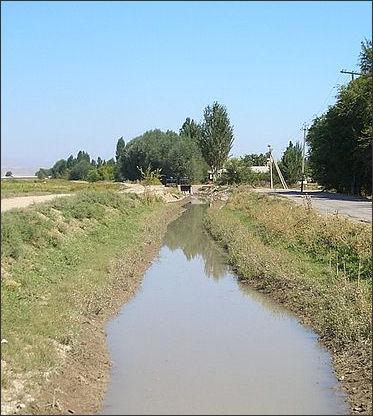
irrigation water evaporates
About 6,000 people die each day of water-borne diseases such a typhoid, diarrhea, hepatitis cholera and dysentery. About 5,000 children die everyday of diarrhea because of a lack of hygiene and sanitation. Dirty water kills more kids than AIDS, malaria , war and accidents put together.
More than 100 pathogens can cause illness if you drink or swim in water contaminated by sewage. They include viruses such hepatitis A, and norovirus Norwalk, and bacteria such as E. Coli, shigella, and campylobacter and parasites such as cryptosporidium (a protozoa spread in fecal matter chlorine doesn’t kill), naegleria fowleri and giardia and flatworms such as schistosoma.
On top of that chemicals and toxins such as PCBs, metals and things like growth hormones and chemicals from soap also enter the water. By one count 1,000 new synthetic compounds enter the water system every year and seep into drinking water. [Source: Natural History magazine, November 2007]
Blooms of algae and plankton can be toxic in their own rite plus they can contain pathogens such as the bacteria that cause cholera. Algae blooms are aided by nitrogen and phosphorous from human waste, and agricultural runoff.
Image Sources: Wikimedia Commons
Text Sources: New York Times, Washington Post, Los Angeles Times, Times of London, Yomiuri Shimbun, The Guardian, National Geographic, The New Yorker, Time, Newsweek, Reuters, AP, Lonely Planet Guides, Compton’s Encyclopedia and various books and other publications.
Last updated April 2022

